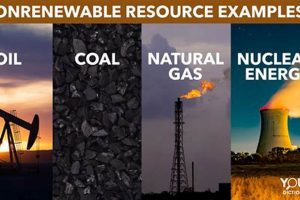
Energy derived from motion or position, such as a rotating turbine or a compressed spring, can be categorized based on its source. For instance, a hydroelectric dam harnesses the movement of water,... Read more »

Heat derived from the Earth’s subsurface can be harnessed as a power source. This thermal energy originates from the planet’s formation and the decay of radioactive isotopes within its core. Accessing this... Read more »

Hydropower, the generation of electricity from water, utilizes the natural water cycle, a continuous process powered by solar energy. A dam typically impounds water in a reservoir, and this stored potential energy... Read more »

Ocean energy derives from various sources, including tides, waves, currents, and thermal and salinity gradients. These sources are naturally replenished through cyclical processes like the lunar cycle, wind patterns, and solar radiation.... Read more »

Fossil fuels, like coal, oil, and natural gas, and nuclear fuels, such as uranium, represent finite energy sources. These materials are extracted from the Earth and are not replenished at a rate... Read more »

Coal is categorized as a nonrenewable energy source because its formation takes millions of years. Organic matter, primarily plants, accumulates in swamps and bogs. Over time, this matter is buried under layers... Read more »

Water-powered electrical generation relies on the continuous flow of water through turbines to create energy. This process harnesses a naturally replenishing resource, driven by the water cycle of evaporation, condensation, and precipitation.... Read more »

Understanding the distinction between energy sources that replenish naturally and those that exist in finite quantities is fundamental to addressing global energy demands and environmental sustainability. Renewable resources, such as solar, wind,... Read more »

Certain energy sources are finite and deplete over time, taking millions of years to replenish naturally. These resources, derived from geological processes involving ancient organic matter, include fossil fuels like coal, oil,... Read more »

Sustainable energy sources, those that replenish naturally over a relatively short period, stand in contrast to finite resources that are depleted through consumption. Examples of the former include solar, wind, hydro, geothermal,... Read more »


